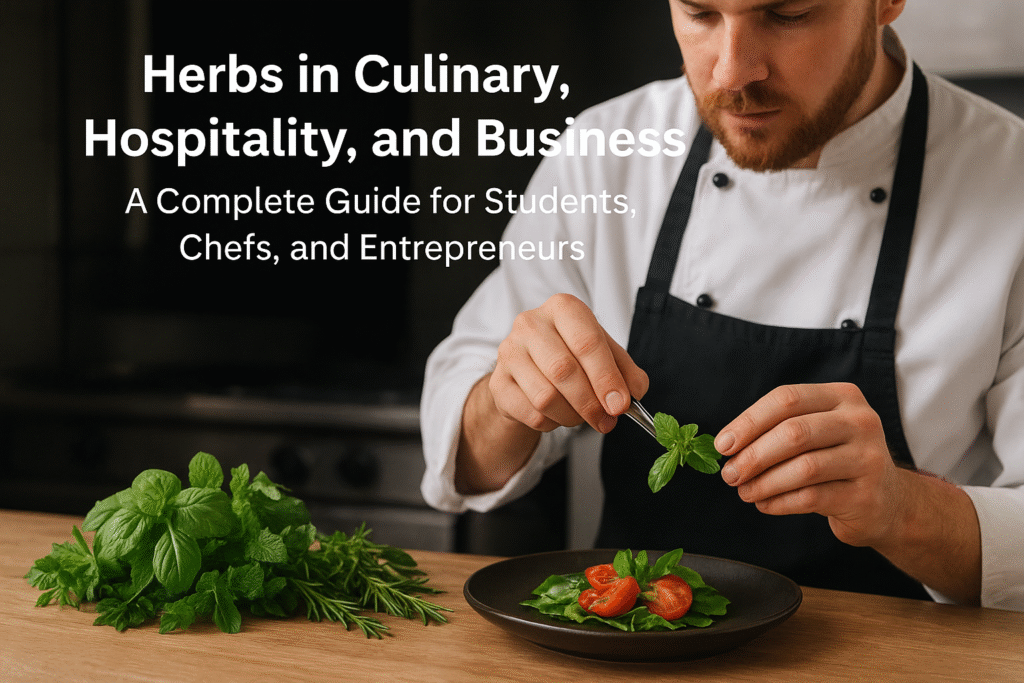🌿 Herbs in Culinary, Hospitality, and Business: A Complete Guide for Students, Chefs, and Entrepreneurs

🌿 Herbs in Culinary, Hospitality, and Business: A Complete Guide for Students, Chefs, and Entrepreneurs
Introduction
In the world of food and hospitality, herbs are more than just green leaves — they are the heart of flavor, aroma, and presentation. From basil in Italian pasta to coriander in Indian curries, herbs define a cuisine’s identity and play a major role in nutrition, wellness, and business innovation.
For hospitality students, chefs, and food entrepreneurs, understanding herbs is essential — not only for culinary excellence but also for market success in today’s health-driven global food industry.
🌱 What Are Herbs?
Herbs are soft, green, leafy plants used for flavoring food, enhancing aroma, or medicinal purposes. They usually come from the non-woody parts of plants, unlike spices, which are derived from roots, bark, or seeds.
In culinary and hospitality training, herbs are taught as natural ingredients that elevate dishes without artificial additives — aligning with the growing global trend of natural, clean-label, and organic food.
Examples: Basil, Mint, Parsley, Coriander, Thyme, Rosemary, and Oregano.
🧩 Categories of Herbs
- Culinary Herbs
Used mainly for cooking and flavoring. Culinary herbs bring life to dishes and are a key part of professional kitchen training.
Popular Culinary Herbs:
Basil: Italian dishes, pesto, and tomato sauces.
Parsley: Used as garnish or in soups and salads.
Coriander (Cilantro): Common in Asian and Latin cuisines.
Thyme and Rosemary: European and Mediterranean dishes.
Mint: Used in drinks, desserts, and salads.
Hospitality Relevance:
Chefs and culinary students must learn flavor pairings — for example, basil complements tomato, rosemary enhances lamb, and mint pairs beautifully with yogurt. Culinary herbs help build signature recipes and improve plate aesthetics.
- Medicinal Herbs
These herbs are known for their healing and wellness properties. Many hotels and resorts now offer herbal teas and spa products as part of wellness tourism.
Common Medicinal Herbs:
Tulsi (Holy Basil): Immunity booster and stress reliever.
Chamomile: Calming tea for guests.
Ginger and Turmeric: Anti-inflammatory and digestive benefits.
Aloe Vera: Used in spa treatments and health drinks.
Hospitality Relevance:
Wellness resorts and restaurants can create unique herbal menus — herbal detox teas, Ayurvedic cuisines, and herbal-infused beverages — that attract health-conscious travelers.
- Aromatic Herbs
Aromatic herbs are rich in essential oils and used in perfumes, aromatherapy, and cosmetics. They are also used in fine dining for fragrance enhancement.
Examples: Lavender, Lemongrass, Sage, and Rosemary.
Hotels often use these herbs in spa oils, room fragrances, and signature guest amenities.
- Ornamental Herbs
Grown for decoration and fresh air, ornamental herbs like Lavender, Lemon Balm, and Sage are used in restaurant gardens and hotel landscaping. Many boutique restaurants now use “herb walls” or rooftop herb gardens for a sustainable touch.
🧺 Fresh vs Dried Herbs: Understanding the Difference
Feature Fresh Herbs Dried Herbs
Flavor Delicate, bright Strong, concentrated
Shelf Life 3–10 days 6–12 months
Usage Added at end of cooking Added during cooking
Packaging Breathable bags, clamshells Airtight jars, foil pouches
Chef Tip:
Fresh herbs enhance visual appeal and aroma, while dried herbs are convenient for sauces, marinades, and bulk preparation.
Hospitality Relevance:
Understanding the right use of fresh and dried herbs helps maintain consistency in restaurant flavor profiles and cost management.
📦 Herb Packaging in Food Business
Proper packaging ensures herbs retain aroma, color, and nutrients.
For Fresh Herbs:
Use breathable perforated pouches or PET clamshell boxes.
Keep under 4°C–8°C temperature.
Moisture control pads help extend shelf life.
For Dried Herbs:
Use vacuum-sealed or nitrogen-flushed packs.
Store away from light and humidity.
Label with botanical name, origin, and expiry date (important for export compliance).
Packaging Materials:
Glass jars, foil pouches, PET bottles, zip-lock sachets, and compostable eco packs.
Entrepreneur Tip:
Sustainable packaging adds brand value — especially for export buyers in Europe and North America who prefer eco-friendly materials.
🍳 Culinary Uses of Herbs
Flavoring and Seasoning
Herbs are used in soups, sauces, marinades, pizzas, grills, and salads. The art of using herbs distinguishes a professional chef from an amateur cook.
Garnishing
Parsley, coriander, and chives are common garnishes that enhance color and presentation.
Infused Oils and Butters
Chefs create herb-infused olive oils or garlic-herb butters for bread service and sauces.
Beverages and Teas
Mint, lemongrass, and basil are used in mocktails, teas, and detox drinks.
Desserts
Mint, lavender, and basil add sophistication to desserts and ice creams.
Hospitality Relevance:
Students and chefs must master herb pairing principles to balance flavors — for example, pairing thyme with chicken or mint with lamb creates harmony.
🌿 Medicinal and Nutritional Benefits
Herbs contain vitamins, minerals, and antioxidants that support immunity and digestion.
Basil: Rich in vitamin K.
Parsley: Source of vitamin C and iron.
Coriander: Aids digestion.
Thyme: Antibacterial properties.
Wellness Tourism Trend:
Modern hotels are introducing herbal wellness menus combining nutrition, detox drinks, and spa therapies — making herbs a key ingredient in hospitality innovation.
💼 Business Ideas in the Herb Industry
- Organic Herb Farming
Start a small farm cultivating basil, mint, or lemongrass. Sell to restaurants, hotels, and supermarkets. Hydroponic herb farming is now trending.
- Dried Herb Processing & Export
Collect, wash, dry, and package herbs for the retail and export market.
Countries like India, Egypt, and Turkey are major exporters.
- Herbal Tea & Infusion Business
Create branded herbal teas (mint, tulsi, chamomile).
Add creative packaging and online marketing through Amazon or Shopify.
- Essential Oils & Cosmetics
Distill oils from lemongrass, lavender, and rosemary for perfumes and spa products.
- Herb Nurseries & Online Stores
Sell potted herbs for home kitchens and hotels. Eco-lifestyle lovers love to grow herbs indoors.
- Culinary Product Line
Produce herb-blended salts, spice mixes, or sauces for B2B and retail.
- Herb-Based Restaurant Concepts
Open cafes focused on herbal drinks, organic salads, and farm-to-table cuisine.
Entrepreneur Insight:
The demand for herbs grows 8–10% annually. Combining hospitality experience with herbal innovation can create strong business opportunities.
🌍 Global Herb Market Overview
The global herbal market was valued at around USD 150 billion in 2025, projected to reach USD 250 billion by 2032.
Growth is driven by:
Rising health awareness
Demand for natural food ingredients
Organic farming expansion
Growth of the hospitality and spa sectors
Top Producers: India, China, Egypt, Morocco, Turkey
Top Importers: USA, Germany, France, Japan, UAE
Export Opportunities:
Dried basil, mint, thyme, and oregano are in high demand worldwide. Value addition (cleaning, sorting, packaging) increases profit margins significantly.
🍝 Herbs in Global Cuisines
Cuisine Key Herbs Description
Italian Basil, Oregano, Parsley Foundation of pasta sauces and pizzas
French Tarragon, Thyme, Chervil Used in classic “Herbes de Provence” blends
Middle Eastern Mint, Parsley, Coriander Core ingredients in tabbouleh and kebabs
Indian Coriander, Curry Leaves, Tulsi Adds layers of aroma in curries and teas
Thai Lemongrass, Thai Basil, Mint Balances spice and freshness
Mexican Cilantro, Epazote, Oregano Adds depth to tacos and salsas
Mediterranean Rosemary, Sage, Thyme Used in roasted meats and seafood dishes
Chef Tip:
Every cuisine has its “signature herb.” Learning these helps chefs create authentic international dishes and global-standard menus.
🌾 Herb Cultivation & Sustainability
Sustainable herb farming practices include:
Using organic fertilizers and rainwater harvesting.
Avoiding pesticides to preserve flavor and purity.
Growing herbs locally to reduce carbon footprint.
Hospitality Relevance:
Eco-friendly hotels can establish on-site herb gardens to supply fresh herbs to their restaurants — an excellent branding and sustainability initiative.
🧠 Why Hospitality Students Must Learn Herbs
Enhances culinary creativity – learning herb pairing and menu design.
Improves nutrition knowledge – guests value healthy menus.
Prepares for global cuisines – essential for international careers.
Opens business opportunities – from organic farming to herbal products.
In summary, herbs connect the kitchen, wellness, and business worlds — making them one of the most versatile subjects for hospitality professionals.
📊 Conclusion
Herbs are not just culinary ingredients — they are a bridge between flavor, health, and sustainability.
For hospitality students, they offer academic and practical knowledge.
For chefs, they define creativity and authenticity.
For entrepreneurs, they open doors to profitable ventures in food, health, and cosmetics.
From a small rooftop herb garden to a global herbal brand — the potential is limitless.
As the world shifts toward natural and organic living, those who understand herbs deeply will always stay ahead in the hospitality and food business industry.
Expand Your Reading
Discover more content you might enjoy
